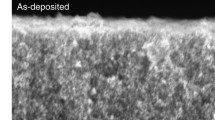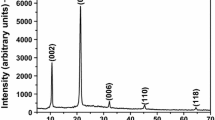Abstract
The non-polymeric organic compound: 3,4,9,10 - perylenetetracarboxylic dianhydride (PTCDA) has recently been observed to undergo a large increase in conductivity on irradiation with energetic particle beams. In this paper we discuss the unique properties of both the as-deposited and irradiated forms of PTCDA and related compounds. When the organic compounds are irradiated with 2 MeV Ar+; beams, their resistivity can be reduced over 14 orders of magnitude from ρ (300K) =; 1010 Ω-cm (as-deposited) to ρ (300K) = 5 × 10-4 Ω-cm using a maximum dose of 1017 ions/cm.2 The temperature dependence of the resistivity for doses 1016cm−2 follows ρ(T) ∝ exp (-const./ T1/2) consistent with conduction due to hopping of carriers between isolated, conducting islands formed furing the irradiation process. In addition, we report on studies of structural changes induced by particle irradiation. The unirradiated PTCDA was vacuum sublimed onto (100), 10 Ω-cm p-Si substrates yielding a rectifying contact barrier with a height of ϕB = 0.74 eV. The diodes thus formed undergo avalanche breakdown at Vg = 230V, and exhibit current densities at VB/2 of ≤50 μ A/cm.2 In addition, the forward current-voltage (IF-V) characteristics are strongly dependent on the contact metal used on the top PTCDA surface. The rectifying characteristics reported for the as-deposited material, coupled with the electronic and optical properties of irradiated PTCDA and related compounds suggest that these are interesting electronic materials whose potential device applications appear worthy of further study.
Similar content being viewed by others
References
P. H. Schmidt, D. C. Joy, M. L. Kaplan, and W. L. Feldmann, Appl. Phys. Lett.40, 93 (1982).
S. R. Forrest, M. L. Kaplan, P. H. Schmidt, T. Venka-tesan, and A. J. Lovinger, Appl. Phys. Lett.41, 708 (1982).
S. R. Forrest, M. L. Kaplan, P. H. Schmidt, W. L. Feldmann, and E. Yanowski, Appl. Phys. Lett.41, 90 (1982).
Obtained from Aldrich Chemical Co. Inc., Milwaukee, Wise. 53233. Purified by gradient sublimation.
Obtained from Eastman Kodak Co., Rochester, NY. Purified by gradient sublimation.
F. Gutmann and L. E. Lyons, " Organic Semiconductors," (Wiley, New York, 1967).
P. Sheng, B. Abeles, and Y. Arie, Phys. Rev. Lett.31, 44 (1973).
S. M. Sze, " Physics of Semiconductor Devices," 2nd Ed., Wiley, NY (1982).
S. R. Forrest, M. L. Kaplan, and P. H. Schmidt, to be published.
A. Rose, " Concepts in Photoconductivity and Allied Problems," (Interscience, NY, 1963).
Author information
Authors and Affiliations
Rights and permissions
About this article
Cite this article
Kaplan, M.L., Forrest, S.R., Schmidt, P.H. et al. Unique optical and electronic properties of thin film, non-polymeric compounds for device applications. J. Electron. Mater. 12, 989–1001 (1983). https://doi.org/10.1007/BF02654970
Received:
Issue Date:
DOI: https://doi.org/10.1007/BF02654970




